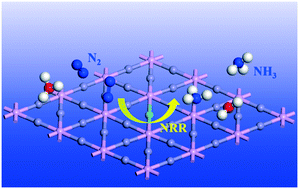Highly stable Mo-doped Fe2P and Fe3P monolayers as low-onset-potential electrocatalysts for nitrogen fixation†
Abstract
Ammonia (NH3) is an essential ingredient for fertilizer production and a carbon-free energy carrier for engineering applications. Searching for novel electrocatalysts with low onset potential, high selectivity and excellent stability is still one of the most attractive and challenging topics. Here, based on the conductor-like screening model and first-principles calculations, we systematically investigated nitrogen reduction reaction (NRR) pathways occurring on iron-based phosphide monolayers. It can be found that Mo-doped Fe2P and Fe3P monolayers can efficiently promote the NRR with onset potentials of −0.30 V and −0.17 V, respectively, especially for the Mo-doped Fe3P monolayer, which has the lowest onset potential to date. Electronic analysis shows that the Mo atom doping can significantly enhance the degree of matching between the d-orbitals of transition metal atoms and the p-orbitals of the N2 molecule, contributing to the activation of dinitrogen. Furthermore, Mo and Fe atoms provide bimetallic active sites, helping to avoid the linear relationship during the NRR pathway. Besides, the competing hydrogen evolution reaction (HER) is suppressed because of larger onset potentials and ab initio molecular dynamics (AIMD) simulations were performed to identify the high stabilities of the Mo-doped monolayers. This work offers useful insights into the design of high-performance electrocatalysts for the NRR and provides guidance for future experimental and theoretical investigations.



 Please wait while we load your content...
Please wait while we load your content...